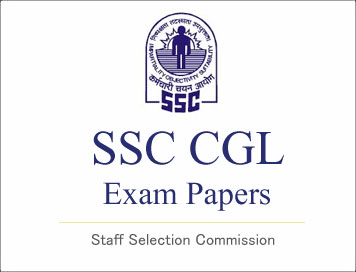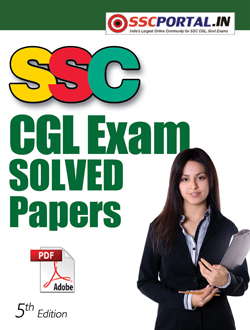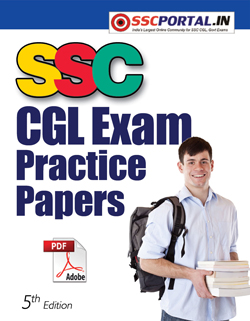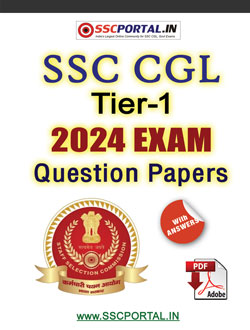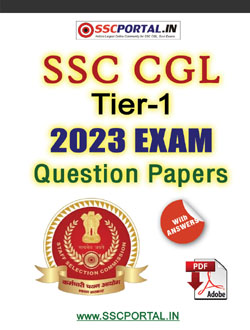NEW! SSC CGL PDF NOTES
SSC CGL (Pre.) Previous Year Solved Paper - 2014, 2nd Shift "Reasoning"
SSC CGL (2 shift) Previous Year Solved Paper - 2014
Subject: Reasoning
1. In a raw, 25 trees are planted at equal distance from each other. The distance between 1st and 25th three is 30m. What is the distance between 3rd and 15th tree?
(a) 8 m
(b) 15 m
(c) 16 m
(d) 18 m
2. In a class composed of x girls and y boys what part of the classes is composed of girls?
(a) y(x+y)
(b) x/xy
(c) x/(x+y)
(d) y/xy
3. If a number is greater than 5 but less than 9 and greater than 7 but less than 11, the number is
(a) 5
(b) 6
(c) 7
(d) 8
Direction (Q. Nos. 4 and 5): In the following questions, select the word which cannot be formed using the letters of the given word.
4. Stimulation
(a) Station
(b) Nation
(c) Motion
(d) Mouth
5. Institutionalise
(a) Nutrition
(b) Intuition
(c) Tuition
(d) Insulation
6. If MONKO is coded as 57637, then how KLJMN be coded in the same code?
(a) 32456
(b) 34256
(c) 35156
(d) 32546
7. In a certain code, TRIPLE is written as SOHOKD. How is DISPOSE written in that code?
(a) CHRONRD
(b) DSOESPI
(c) ESJTPTF
(d) ESOPSID
8. Which letter is the word ‘Vertix’ should be changed to mean spiral movement?
(a) 1st
(b) 2nd
(c) 4th
(d) Last
9. If TRANSFER is coded as RTNAFSRE, the how ELEPHANT be coded in the code language?
(a) LEPEHATN
(b) LEPEAHTN
(c) LEEPAHTN
(d) LEPEAHNT
10. If ‘-’ stands for addition, ‘+’ stands for subtraction, ‘÷’ stands for multiplication and ‘×’ stands for division, then which one of the following equation is correct?
(a) 50 × 2 ÷ 2 – 30 + 25 = 25
(b) 50 – 30 + 5 ÷ 2 × 30 = 25
(c) 40 + 35 × 2 – 50 + 30 = 95
(d) 30 × 2 – 25 + 50 + 5 = 100
(E-Book) SSC CGL (Tier-1) Exam Question Papers PDF
Click Here to Join SSC CGL (Tier -1) Online Crash Course
Click Here to Buy SSC CGL (Tier -1) Study Kit in Print Copy
11. Which of the following interchange of signs would make the equation correct?8 × 6 + 2 = 22
(a) +, ×, 2 and 6
(b) +, ×, 2 and 8
(c) +, ×, 6 and 8
(d) +, ×, 2 and 22
Directions (Q. Nos. 12 and 13): In the following questions, some equations are solved on the basis of certain system. Find out the correct answer for the unsolved equation on the basis.
12. 3 × 5 × 7 × 2 = 24, 2 × 4 × 6 × 8 = 22, 4 × 4 × 8 × 9 = ?
(a) 33
(b) 25
(c) 144
(d) 1152
13. 2 × 4 × 6 = 4; 9 × 3 × 7 = 13; 4 × 7 × 6 = 3; 9 × 7 × 8 = ?
(a) 10
(b) 09
(c) 08
(d) 07
Directions (Q. Nos. 14-16): In the following questions, find the missing number from the given responses.
14. 2 3 4 ?
3 1 4 2
4 2 2 6
5 5 2 2
196 121 144 225
(a) 4
(b) 5
(c) 6
(d) 3
15. 99 ? 168
32 48 56
16 24 28
(a) 52
(b) 144
(c) 64
(d)
16. 7 8 5
6 9 ?
2 3 6
84 214 900
(a) 90
(b) 70
(c) 65
(d) 3
Directions (Q. Nos. 17-22): In the following questions, select the related words/letters/numbers from the given alternativ
17. AYRRJC : CATTLE : : NCPDCAR : ?
(a) SUBJECT
(b) NEGLECT
(c) PERFECT
(d) OPERATE
18. SOCIAL : OCIALS : : DRIVEN : ?
(a) VERNID
(b) NEVIRD
(c) RIVEND
(d) VIREND
19. 
(a) 128
(b) 126
(c) 144
(d) 132
20. 64 : 36 : : 81 : ?
(a) 0
(b) 1
(c) 2
(d) 3
21. Embarrassed : Humiliated : : Frightened : ?
(a) Terrified
(b) Agitated
(c) Courageous
(d) Reckless
22. Macabre : Lovely : : Baneful : ?
(a) Unharmful
(b) Churlish
(c) Filter
(d) Ugly
Directions (Q. Nos. 23-28): In the following questions, find the odd word/letters/ numbers from the given alternatives.
23.
(a) Autobiography
(b) Malayalam
(c) Intelligence
(d) Dictionary
24.
(a) Square
(b) Trapezium
(c) Cylinder
(d) Parallelogram
25.
(a) Yacht
(b) Submarine
(c) Boat
(d) Ship
26.
(a) Year 2012
(b) Year 1998
(c) Year 2005
(d) Year 1997
27.
(a) MIGE
(b) XTQO
(c) RNKI
(d) HDAY
28.
(a) 42 : 4
(b) 48 : 6
(c) 32 : 2
(d) 15 : 5
29. Which one of the given responses would be a meaningful order of the following?
(1) Absorption
(2) Digestion
(3) Nutrition
(4) Excretion
(a) 3, 1, 2, 4
(b) 2, 1, 3, 4
(c) 3, 4, 2, 1
(d) 3, 2, 1, 4
30. Arrange the following words as per order in the dictionary.
(1) Euphrasy
(2) Eupepsy
(3) Euphonic
(4) Eugenic
(5) Euphon
(a) 4, 3, 2, 1, 4
(b) 3, 4, 1, 2, 5
(c) 4, 2, 3, 5, 1
(d) 3, 5, 2, 4, 1
Directions (Q. Nos. 31-34): In the following questions, a series is given with one term missing. Choose the correct alternative from the given one that will complete the series.
31. 1, 5, 25, 125, ?, ?, ?
(a) 245, 485, 965
(b) 225, 325, 425
(c) 625, 3225, 15605
(d) 325, 3125, 15625
32. 0, ?, 8, 27, 64, 125
(a) 5
(b) 4
(c) 2
(d) 1
33. BMX, DNW, FOU, ?
(a) GHO
(b) GPS
(c) HPS
(d) HPT
34. DHK, GKN, JNQ, ?
(a) MRU
(b) MQT
(c) LPS
(d) NRU
35. Select the alternative inference which is most appropriate. “All professors are learned; learned people are always gentle.” Inference All professors are gentle person.
(a) The inference is true
(b) The inference is false
(c) The inference is probably true is probably false
(d) The inference is irrelevant
Directions (Q. No. 36): A statement is given followed by two Inference I and II. You have to consider the statement to be true even if it seems to be at variance from commonly known facts. You have to decide which of the given inferences, if any, follow from the given statement?
36. Statement: “Electric supply in Anand Colony will be cut tomorrow after 12 O’clock for three hours because repairing work will be carried out.”
Inferences
I. Residents of Anand colony may use their electrical appliances before 12 o’clock tomorrow.
II. Residents of Anand colony need training for using electricity economically.
(a) Only inference I follows
(b) Only inference II follows
(c) Both the inferences follow
(d) None of the inferences follows
37. Anand travels 10 km from his home to the East to reach his school. Then, he travels 5 km to the South to reach his father’s shop, after school. He, then travels 10 km to the West to help his uncle. How far and in which direction is he from his home?
(a) 10 km, North
(b) 5 km, South
(c) 5 km, East
(d) 10 km, West
38. Four villages, A, B, C and D lie in a straight line. D is 10 km from B. A is exactly between D and C and C from B is 2 km more than it is from D. How far is C from B?
(a) 4 km
(b) 6 km
(c) 8 km
(d) 2 km
Directions (Q. Nos. 39-40): In the following questions, among four answer figures whose cut pieces can form the given question figure.
39. Question Figu
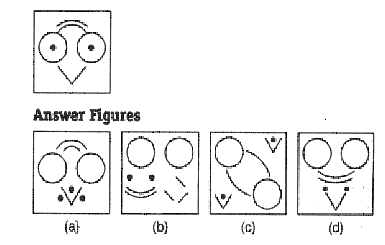
40. Quetion Figure
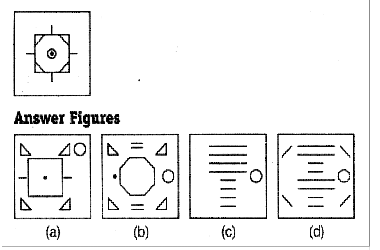
41. Which of the following answer figures cannot occur when the question figures given below is rotated
QuestionFigure
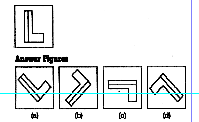
Directions (Q. Nos. 42 and 43): In the following questions, which of the following venn diagrams best represents the relation between given classes
42. Human, Birds, Animals

43. Fruits, Apples, Oranges

44. In the diagram given below which letter(s) represents the students who play cricket as well as football and hockey?
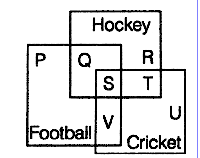
(a) S + T + U
(b) V
(c) S
(d) P + R + U
45. Question Figure
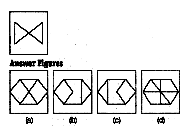
46. Question Figure
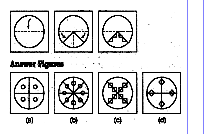
47. From the given answer figures, select the one in which the question figure is hidden/embedded.
Question Figure

48. A piece of paper is folded and cut as shown below in the question figures. From the given answer figures, indicate how it will appear when opened?
Question Figure

49. If a mirror is placed on the line MN, then which of the answer figures is the right image of the given figure?
Question Figure
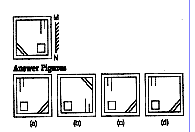
50. A word is represented by only one se t of numbers as given in any one of the alternatives. The sets of numbers given in the alternatives are represented by two classes of alphabets as in two matrices given below. The columns and rows of Matrix I are numbered from 0 to 4 and 2 to 6 respectively and that of Matrix II are numbered from 2 to 6 and 7 to 0 respectively. A letter from these matrices can be represented first by its row and next by its column, e.g., ‘H’ can be represented by 04, 25, 32 etc. and ‘N’ can be represented by 21, 40, 59 etc. Similarly, you have to identify the set for the word given below.
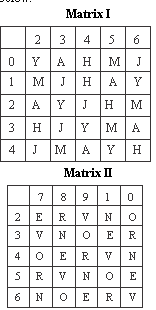
(a) 23,27,15,61
(b) 16,38,15,30
(c) 34,31,32,28
(d) 45,50,36,2
Answers Key
1. (b) 2. (c) 3. (d) 4. (d) 5. (a) 6. (b) 7. (a) 8. (b) 9. (b) 10. (a)
11. (c) 12. (a) 13. (a) 14. (b) 15. (b) 16. (d) 17. (c) 18. (c) 19. (a) 20. (a)
21. (a) 22. (a) 23. (c) 24. (c) 25. (b) 26. (a) 27. (a) 28. (a) 29. (b) 30. (c)
31. (d) 32. (d) 33. (c) 34. (b) 35. (a) 36. (a) 37. (b) 38. (a) 39. (d) 40. (b)
41. (c) 42. (c) 43. (c) 44. (c) 45. (a) 46. (a) 47. (a) 48. (c) 49. (c) 50. (a)


